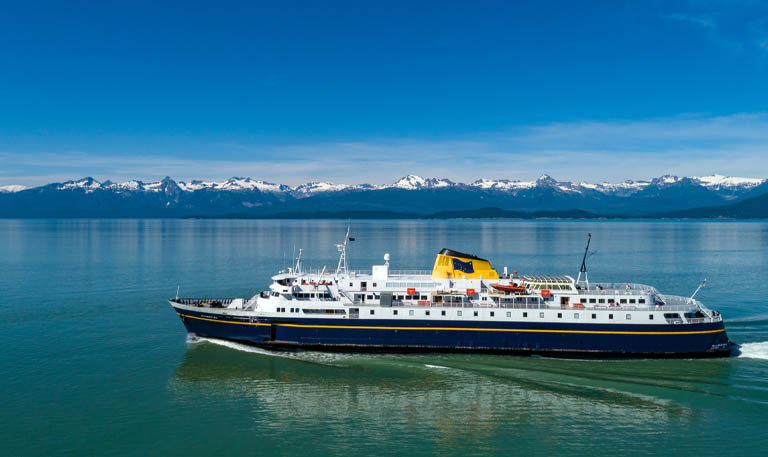Take the next vacation on an Alaska Marine Highway System ferry
With our 3,500-mile drive to Alaska in the rearview mirror, we crept down the steeply pitched White Pass to the end of the road in Skagway. My wife Deb and I, along with two dogs, a cockatiel named Peaches and a trailer stuffed with personal belongings were relocating to Admiralty Island. And our passage to “the bush” was docked at the water’s edge—an Alaska Marine Highway System (AMHS) ferry.
What we didn’t realize at the time is that this system of nine ferries navigating 3,500 marine miles of coastline and serving 33 communities is more than transportation—much more.
“When you travel on an AMHS ferry, you’re riding with an Alaskan crew and with Alaska residents who, with enthusiasm, will often share local information and advice about their favorite sights, eateries, and things to do,” says Shannon McCarthy, Alaska Department of Transportation and Public Facilities communication director. “A traveler won’t get the prepackaged cruise experience but will have a real Alaskan adventure.”
Danielle Doyle, AMHS marketing manager, says, “If you like the concept of boat travel but aren’t quite sure about a traditional cruise, the ferry might provide the perfect alternative. Or, for those who have experienced Alaska on a prior cruise or organized tour and want to explore more, the ferries will allow them to reach communities not represented on traditional itineraries.”
Board a mainline vessel in Bellingham, Wash., and wind north along the coast of British Columbia in channels so narrow it felt like we could touch the trees. There are 17 port communities in this Southeast region (or “panhandle”) enveloped in “the largest contiguous temperate rainforest in the world.”
According to Doyle, Ketchikan is one of the most popular destinations here. Our walk among “the world’s largest collection of standing totem poles” was an immersion in history and culture. Take a guided tour in the “Salmon Capital of the World” to learn human and wildlife stories of the area.
Select from seven port communities in the South Central coastal region. For a vibrant arts town and world-class fishing, come ashore in Homer. Walk the famous Spit—a four-mile finger of land jutting into Kachemak Bay—for exceptional eagle watching. About this region, Doyle says, “Those traveling with vehicles may community hop but ultimately will end up disembarking at a road head that will provide them access to the interior highway, as in Haines, Skagway, Whittier [and Homer].”
Join our bucket list of 11 ports dotted along the dramatic 1,100-mile sweep of Aleutian Islands in the Southwest region. Largely protected refuge lands, this area is critical for marine mammals and avian species as well as endemic plant species. Dutch Harbor, at the terminus of the AMHS route, is the “number one commercial fishing port in the nation” and surrounded by volcanic peaks, lush green valleys, and a 9,000-year indigenous human history.
McCarthy states, “The ferry system offers a unique look at coastal Alaska, traveling through scenic passages that larger cruise ships are unable to navigate, and to remote but lively fishing towns and culturally rich villages off the beaten path, where there isn’t enough infrastructure to support megaships that carry thousands of passengers.”
Back on the island in our remote fishing village we quickly learned more valuable contributions of AMHS ferries. Tucked into the belly of a day boat, the LeConte, was a truck filled with our groceries and necessities for the community. Its dependably scheduled arrivals also meant we could queue up at the ferry’s eatery for a rare treat—burgers, fries, and other comfort foods on our own (floating) restaurant.
Doyle says, “Either as a walk-on passenger or traveling with a vehicle, [you]can stop and explore the unique communities along the coastal route and experience a vast array of scenic landscapes and wildlife.”
For the particulars, Doyle suggests, “Ferry travel can be scaled to fit almost any budget if travelers are willing to embrace their adventurous side and pitch a tent on deck or pack aboard their own cooler full of snacks.” Our short passages (Aurora, LeConte, Tazlina, Hubbard and Lituya) involved sleeping bags and a backpack “pillow.” We booked a cabin during longer voyages on the mainline vessels (Columbia, Matanuska, Kennicott and Tustumena).
“A day trip can easily fit into most travel itineraries and fly/ferry combinations are a great way to experience the ferry for those that may be on a tighter timeframe,” Doyle says. And, when float planes to and from our island were grounded by weather, we could depend on ferries and the folks who kept them going.
AMHS ferries plying the waters of this National Scenic Byway added an unexpected depth and breadth to our Alaska experiences—an integral connectivity. Visitors have the same opportunity to connect with and participate in, rather than simply “see,” the cultures, history, and communities of Alaska. An experience we would have missed had we not traveled like a local!
For More Information Go To: dot.alaska.gov/amhs
Angela Minor has lived, traveled, (and birded) the U.S., Alaska, Caribbean, and seven European countries. Freelance travel writer is her third career iteration, following teacher and small business owner. She writes for travel publications including Blue Ridge Country, Smoky Mountain Living, Ft. Myers Magazine, and international cruise sites; serves as field editor with Birds & Blooms and “park watch” beat writer for 10,000 Birds; and authors the Bird Watcher’s Digest state park birding series.


